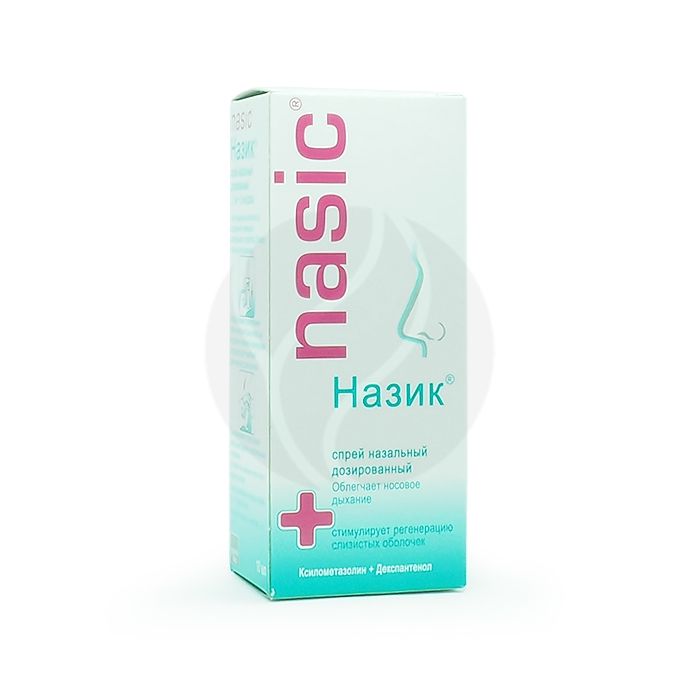Nasik spray 0.1mg + 5mg / dose, 10ml
Expiration Date: 05/2027
Russian Pharmacy name:
Назик спрей 0,1мг+5мг/доза, 10мл
Acute respiratory diseases with symptoms of rhinitis;
acute allergic rhinitis;
vasomotor rhinitis;
sinusitis;
otitis media (as part of combination therapy to reduce swelling of the nasopharyngeal mucosa);
to facilitate rhinoscopy;
to restore disturbed nasal breathing after surgical interventions in the nasal cavity.
Intranasally.
For adults and children over 6 years old. Take the pump dosing device out of the packaging. Uncork the bottle with the drug, screw the dosing device onto the neck of the bottle, remove the protective cap. Before the first use of the spray, press the pump dispenser several times until a uniform spray appears. When using a nasal spray, the bottle must be kept upright.
During injection, you need to inhale easily through your nose. One injection into each nasal passage 3-4 times a day. The duration of therapy is 3-5 days.
Dosed nasal spray, transparent, colorless.
1 dose
xylometazoline hydrochloride 0.1 mg dexpanthenol 5 mg
Excipients: benzalkonium chloride 0.04 mg, potassium dihydrogen phosphate 0.853 mg, sodium hydrogen phosphate dodecahydrate 0.027 mg, purified water 93.98 mg.
Hypersensitivity to the components of the drug; arterial hypertension; tachycardia;
severe atherosclerosis;
atrophic rhinitis;
hyperthyroidism;
porphyria;
hyperplasia of the prostate;
glaucoma;
surgical interventions on the meninges (in history);
children under 6 years of age;
simultaneous therapy with monoamine oxidase inhibitors (MAO) and tricyclic antidepressants.
With care: diabetes mellitus, pheochromocytoma.
pharmachologic effect
Xylometazoline belongs to the group of local vasoconstrictor agents (decongestants) with alpha-adrenomimetic activity, causes narrowing of the blood vessels of the nasal mucosa, restores the patency of the nasal passages, and facilitates nasal breathing. The effect of the drug usually occurs within a few minutes after its use and lasts up to 10 hours. Dexpanthenol - a B vitamin - a derivative of pantothenic acid. Dexpanthenol is converted in the body into pantothenic acid, which is an integral part of coenzyme A and is involved in the processes of acetylation, carbohydrate and fat metabolism, in the synthesis of acetylcholine, corticosteroids, porphyrins; stimulates the regeneration of the skin, mucous membranes, normalizes cell metabolism, accelerates mitosis and increases the strength of collagen fibers. Renders regenerating,metabolic and weak anti-inflammatory effect.
Pharmacokinetics
Xylometazoline, when applied topically, is practically not absorbed, plasma concentrations are so small that they cannot be determined by modern analytical methods. Dexpanthenol, when applied topically, is rapidly absorbed by the skin and turns into pantothenic acid, binds to plasma proteins (mainly beta-globulin and albumin). Its concentration in the blood is 0.5-1 mg / l, in the blood serum - 100 ?g / l. Pantothenic acid is not metabolized in the body (except for inclusion in Co-A), it is excreted unchanged.
Side effect
With frequent and / or prolonged use - irritation and / or dryness of the nasopharyngeal mucosa, burning, tingling, sneezing, hypersecretion, allergic reactions, swelling of the nasal mucosa, vomiting, headache, dry rhinitis, palpitations, increased blood pressure, insomnia, visual impairment, depression (with prolonged use of high doses).
Application during pregnancy and lactation
Given that there is no data on the reproductive toxicity of the drug, its use is not recommended during pregnancy and lactation.
Application in children
Contraindicated in children under 6 years of age.
special instructions
Before use, you must clean the nasal passages. Should not be used for more than 5 days. Influence on the ability to drive vehicles and control mechanisms During the period of use of the drug, you should observe precautions, or avoid driving vehicles and engaging in other potentially hazardous activities that require increased concentration of attention and speed of psychomotor reactions.
Overdose
In cases of overdose or accidental oral administration, the following symptoms may occur: mydriasis, nausea, vomiting, cyanosis, fever, convulsions, tachycardia, cardiac arrhythmias, vascular insufficiency, cardiac arrest, hypertension, pulmonary edema, respiratory failure, hallucinations. Patients may also develop symptoms of CNS depression, accompanied by drowsiness, a decrease in body temperature, bradycardia, shock, respiratory arrest, and coma. Treatment. The use of activated carbon, gastric lavage, oxygen ventilation of the lungs. To lower blood pressure, 5 mg of phentolamine in 0.9% sodium chloride solution is prescribed by slow intravenous administration or 100 mg of phentolamine orally. Vasoconstrictor drugs are contraindicated. If necessary, antipyretic and anticonvulsants are used.
Drug interactions
With the simultaneous use of MAO inhibitors and tricyclic antidepressants, an increase in systemic action is possible.

